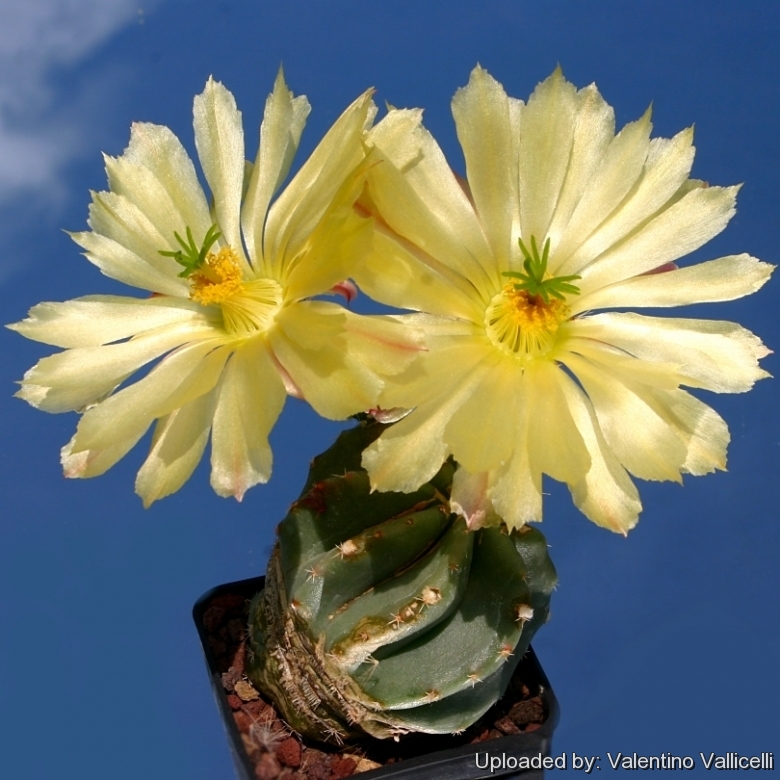
Echinocereus subinermis cv. Spiral Photo by: Valentino Vallicelli
Origin and Habitat: Garden origin (Nursery produced cultivar)
Synonyms:
See all synonyms of Echinocereus subinermis
Description: Echinocereus subinermisSN|16544]]SN|16544]] is the least armed species of the genus with very short spines and huge yellow blooms. The spiral form Echinocereus subinermisSN|16544]]SN|16544]] cv. Spiral is very rare and sought after by collectors, for its unique spiralling ribs. It is considered by many one of the nicest spiral ribbed species. However only the seedling up to 3-5 years old show the characteristic spiral ribs, as plants mature they usually start producing normal straight or slightly curved ribs. Echinocereus subinermisSN|16544]]SN|16544]] cv. Spiral is one of the true mutant forms of Echinocereus that 'breeds true' and won't revert back to it's natural form.
Habit: At first simple or slowly clumping.
Stem: When young pale green, afterwards bluish green and finally darker green and more or less purplish, 10-20 cm tall, 7 to 9 cm in diameter.
Ribs: 5-11 with narrow furrows between them, broad somewhat sinuate, rounded, spiralling when young and almost straight with time.
Areoles: Small, slightly woolly, 10-12 mm apart.
Central spines: Usually absent or one very short and inconspicuous to up to 2 cm long, thin and porrect.
Spines: Younger plants have short spines while older ones are almost spineless.
Radial spines: 0 to 10 (usually 3 to 8), widely spreading, small, unequal, conic, yellowish, or creamishi with a darker tip, deciduous, 1 to 8 mm long (or more).
Flowers: Large and showy up to 10-12 cm in diameter near the stem tips and from second to third areoles on the ribs, perianth segments oblanceolate, acute, cream to bright-yellow delicately sweet-scented, often with some reddish midstripes. Stigma with 10-12 green lobes. Filaments light yellow. Spines of areoles on ovary and flower-tube short, white to brown with scarce white wool.
Blooming season: Spring and summer. The individual flowers will last up to six days. Blooming generally begins 4 to 5 years after sowing, as the plant matures.
Fruit: Obovoid, spiny, grey-green with white pulp, deciduous by a longitudinal slit.
Subspecies, varieties, forms and cultivars of plants belonging to the Echinocereus subinermis group
 Echinocereus subinermis Salm-Dyck in Seem. ex Scheer: with usually solitary stems (or with very few branches) often spineless with 5-9 ribs. the floral tube is only slightly woolly (from northern Sinaloa, southern Sonora, south-western Chihuahua)
Echinocereus subinermis Salm-Dyck in Seem. ex Scheer: with usually solitary stems (or with very few branches) often spineless with 5-9 ribs. the floral tube is only slightly woolly (from northern Sinaloa, southern Sonora, south-western Chihuahua) Echinocereus subinermis var. luteus (Britton & Rose) F.M.Knuth: from Sonora and Sinaloa, is generally solitary, has 8 or 9 ribs, no central spine, 6 to 8 radials, up to 8 mm long.
Echinocereus subinermis var. luteus (Britton & Rose) F.M.Knuth: from Sonora and Sinaloa, is generally solitary, has 8 or 9 ribs, no central spine, 6 to 8 radials, up to 8 mm long. Echinocereus subinermis subs. ochoterenae (J.G.Ortega) N.P.Taylor: With branched stems, always spiny with 8 to 11 ribs. the flower tube is noticeably woolly (From northern Sinaloa).
Echinocereus subinermis subs. ochoterenae (J.G.Ortega) N.P.Taylor: With branched stems, always spiny with 8 to 11 ribs. the flower tube is noticeably woolly (From northern Sinaloa). Echinocereus subinermis cv. Spiral: has spiral schaped ribs.
Echinocereus subinermis cv. Spiral: has spiral schaped ribs.
Bibliography: Major references and further lectures
1) Edward Anderson “The Cactus family” Timber Press, Incorporated, 2001
2) Nathaniel Lord Britton, Joseph Nelson Rose “Cactaceae: Descriptions and Illustrations of Plants of the Cactus Family” vol. 4 The Carnegie Institution of Washington, Washington 1923
3) James Cullen, Sabina G. Knees, H. Suzanne Cubey "The European Garden Flora Flowering Plants: A Manual for the Identification of Plants Cultivated in Europe, Both Out-of-Doors and Under Glass" Cambridge University Press, 11/Aug/2011
12) David R Hunt; Nigel P Taylor; Graham Charles; International Cactaceae Systematics Group. "The New Cactus Lexicon" dh books, 2006
13) Hernández, H.M., Gómez-Hinostrosa, C. & León de la Luz, J.L. 2013. Echinocereus subinermis. In: IUCN 2013. "IUCN Red List of Threatened Species." Version 2013.1. <www.iucnredlist.org>. Downloaded on 24 October 2013.
14) Flora of North America Editorial Committee “Flora of North America: North of Mexico. Magnoliophyta: Caryophyllidae, part 1” Oxford University Press, 1993
15) Karl Schumann “Blühende Kakteen. Iconographia Cactacearum.” Im Auftrage Der Deutschen Kakteen-Gesellschaft Herausgegeben Von Prof. Dr. Karl Schumann (Prof. Dr. Max Gürke, Dr. F. Vaupel). 1900
Cultivation and Propagation: This cactus is cultivated and highly priced for its flowers. It is among the easiest species to grow, flower and propagate.
Waterings: Water regularly from March to October. Rot prone in winter, it needs good drainage.
Hardiness: It can not tolerate much frost. Frost Tolerance: Hardy to -2° C.
Exposition: It does not like full harsh sun as it seems to have a delicate skin and few spines, so give it a protected position in the partial-shade or under filtered sun.
Propagation: Seeds (usually), it also can be grown from cuttings, as it can branch from the base.










